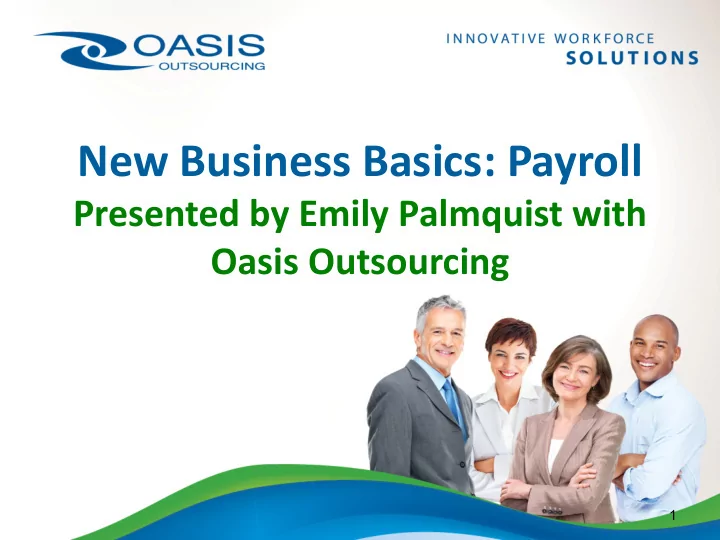

New Business Basics: Payroll Presented by Emily Palmquist with Oasis Outsourcing 1
OUR MISSION A recognized 501c(3) nonprofit organization founded and operated by Veterans in 2004 Missouri * Iowa * Kansas * Nebraska To train, mentor, and assist returning military, National Guard and Reserve members, and their families in addition to our nation’s Veterans as they start and grow small businesses. Transitioning Military Skills Into Small Business Success Funded in part through a cooperative agreement with the US Small Business Administration
All Branches Welcome
New Business Basics: Payroll Presented by Emily Palmquist with Oasis Outsourcing 5
Webinar Agenda • FEIN • W2 or 1099 • Offer Letter • New Hire Packets • Pay Schedule • Pay Options • Taxes • OTHER ITEMS to consider at start up
Company Set Up FEIN The Employer Identification Number, also known as the Federal Employer Identification Number or the Federal Tax Identification Number, is a unique nine- digit number assigned by the Internal Revenue Service to business entities operating in the United States for the purposes of identification. Company Structure C-Corp, S-Corp, LLC, Nonprofit, Sole Proprietorships Tax payments and company structure differ under each umbrella Advisors CPA will help you decide what type of business model is best, handle your taxes and advise you on federal laws that apply to you. Bankers will help with any financial needs and advice.
Types of Employees 1099 W2 • Contract or limited work basis • Hired as an employee, set schedule • Mostly self directed work • Employer dictates work • May have flexible hours • Works when company says to work • Paid an hourly rate • Paid an hourly or salaried rate • Not entitled to benefits • Eligible for benefits • Uses own resources to do work • Company resources available • Pays up to 50% of earnings year end • Pays tax based on IRS limits • No Federal Tax deductions • Federal Tax deductions • Work can end at any time • Employee can resign/ be terminated
Employee Hours and Pay Structure Offer letter Document provided to employees at time of hire detailing pay, hours and company data Hourly or Salaried - Hourly is paid a rate per hour and is eligible for overtime - Salaried is paid the same amount for 40 hours per week, has a guaranteed schedule and is NOT eligible for overtime -The Department Of Labor determines if work is hourly or salaried Full Time or Part Time - FT is more than 30 hours per week and up to 40 total hours - PT is up to 30 hours per week
Exempt vs Non-exempt Non-exempt employee: The FLSA requires that non-exempt employees in the United States be paid at least the federal minimum wage for all hours worked plus overtime pay at time and one-half times the regular rate of pay for all hours worked over 40 hours during a workweek. Exempt employee: The FLSA provides an exemption from both minimum wage and overtime pay for employees who are employed as bona fide executive, administrative, professional, and outside sales employees. The FLSA also exempts certain computer employees.
What’s In A New Hire Packet? Wage Forms - State tax -Federal tax -Direct deposit or pay cards, depending on state I-9 - State ID required -I9 completed through E-Verify in some states -Site employers must keep all I-9 data in a locked cabinet away from the public W-4 -employee federal tax withholdings -can not be stored in same file as I-9 Job Description & Schedule - Please have them sign the job description and keep it in their file -Explain who the employee reports to Company Handbook -Please have them signed that they received it, give them a copy
How To Determine Your Pay Schedule Pay Schedules Pay schedules determine how often you pay employees and/or contractors. Many states have pay schedule frequency requirements for employers, which can be dependent on the size of the company and the industry -Weekly -Bi-Weekly -Semi-Monthly (1 st and 15 th or 15 th and Last Day) -Monthly
Wage Payments & Deductions for Employees Gross Payroll is the total amount of money an employee is paid prior to deductions. Net Payroll is what is in the employee’s check after deductions are taken. Taxes - State tax -Federal tax -Social Security -Medicare -940/941/1094/1095 Garnishments - Will be declared by the debtor or state entity-child support, alimony, student loan default, unpaid taxes, etc. -I9 completed through E-Verify in some states -Site employers must keep all I-9 data in a locked cabinet away from the public Other deductions - Benefits -401k -Other checking/savings accounts
Taxes Social Security=6.2% Completed at 132,900 in 2019 Medicare=1.45% Federal Unemployment 0. 6% up to $7,000 ($42/employee) State Unemployment Ex: MO-2.38% new business rate, stopping at $12,000 in wages Local Taxes Ex: St. Louis City-1%
Compliance Posters Payroll records Employee information
Other Items to Consider Work Comp Vacation Pay EPLI Coverage 401k Options ACA Status Handbook Benefits Administration Human Resources Help
VETERANS QUESTIONS? Maggie Peterson Administrative Director, AWE Program Manager Veterans Business Outreach Center, Region IIV Peterson@vetbiz.com 314-531-8387 www.vetbiz.com 18
Recommend
More recommend